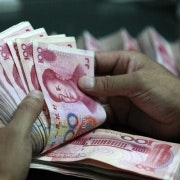From mining to modern art: the Guggenheim legacy
The name Guggenheim is synonymous with art, education and space travel. The Frank Lloyd Wright-designed Solomon R. Guggenheim Museum on Fifth Avenue is one of the biggest drawcards of New York. Its sister museum in Bilbao, Spain, is also another modern architectural masterpiece, which also boasts an impressive collection of modern art.
The Guggenheims have founded or planned to open 10 museums in the world from Abu Dhabi to Guadalajara in Mexico. The fellowship named in honour of John Simon Guggenheim is one of most prestigious in the US for scholars and artists. Guggenheim alumni include more than 100 Nobel Laureates and 35 Poet Laureates of the United States.
However, the Guggenheim dynasty started in the most unlikely place in the world: a small Swiss village called Lengnau, an unmapped place of incomparable ignorance and a hotbed of anti-Semitism. There, the Jews were not allowed to live in a house with tile or stone roofs, only straw. No Jewish marriages were allowed except when the groom and bride could cough up a substantial bribe.
The appalling religious bigotry and the prohibition on Jewish marriage forced the founder of the family fortune, Simon Meyer, to fled Lengnau for the United States. Simon Meyer, a middle-aged widower at the time, brought his new bride Rachel Weil and their 12 children with them to the New World.
The Guggenheims were good traders in the early days, selling anything from textiles to spices. But the fortune was really made when Simon’s son Meyer decided to sink family money into the ground to find copper, lead and other minerals.
The family biographer John H. Davies described the momentous decision as “a single, sudden decision, taken in nearly total ignorance of what its consequences might be, which, on its face value, was nothing short of wild speculation, was ultimately responsible for what the Guggenheim became and what they are today.”
Unlike other speculative investors in wild mining ventures, Meyer Guggenheim got his hands dirty and went out to look at his potential investments. Before long, he decided to capture more profits along the value chain, using modern-day business language. He got into the smelting business and told the family to liquidate its clothing business to concentrate on mining and smelting.
The decision stunned the family because the smelting business was losing a lot of money. But Meyer convinced the family to back him and sent his most enterprising son, Daniel, to Mexico, in search of further business opportunities.
Though the Mexicans hated the Yankees at the time, Daniel was able to charm and befriend then president Porfirio Dia, and convinced him of the virtues of foreign investment. It seems Mexicans hated Protestants more than Jews, according to late Professor David Landes of Harvard, who authored Dynasties: Fortunes and Misfortunes of the World’s Great Family Business. (This article is much indebted to his superb scholarship.)
Daniel won concessions for two smelters and as well as the rights to undertake exploration activities of potential mine that they might lease or buy. Daniel’s Mexican venture laid the foundation for family’s global mining empire.
Like other great family dynasties that benefited from shifting geopolitical fortunes and wars, the Guggenheims made the most of the US’ decision to purchase Alaska from Tsarist Russia. The resources-rich state was regarded as a frozen wasteland at the time and the $7.2 million price tag was dubbed as Seward’s Folly, after the US Secretary of state who sealed the deal.
The next biggest turning point in the family fortune came when Daniel Guggenheim got wind of a green, treeless mountain on Kennecott Creek in Alaska, which supposedly had high copper composition. He sent out his top scout to survey the site and came back with the report that ore tested from site contained 70 to 75 per cent of copper.
The Guggenheims turned to the legendary king of the Wall Street, J.P. Morgan, for money to finance the audacious venture in frozen Alaska. J.P. Morgan was suitably impressed and formed a partnership called Alaska Syndicate with Meyer Guggenheim to build the copper mine in Alaska.
Modern day investors in iron ore mines in the Pilbara will have some sympathy for the Guggenheims. The geography is remote, the environment inhospitable and the cost astronomical. But once these obstacles were conquered, the Kennecott copper mine turned into a money printing press for the family.
By 1918, the Guggenheims had taken out ten times as much from the copper mine as the Russians had paid for all of Alaska in 1867. Seward’s Folly was the Guggenheims’ gain. The family then used the Alaskan river of gold to finance their worldwide grab for resources from Malaysian tin to Angolan diamonds.
The only thing that could derail the Guggenheim empire was growing protests from conservationists. At the time, another family member came to the rescue, Meyer’s brother Simon. He was a senator of the United States who played a quiet and effective role to smooth out things for the business. Who else could you rely on?
After the Guggenheims plundered the earth for mineral riches, the family members decided to turn to philanthropy, like that other great American business dynasty, the Rockefellers. This leads us back to the numerous museums and fellowships endowed by the family over several generations.
The late David Landes wrote: “the Guggenheim descendants now devote themselves to philanthropy, to supporting art, science, scholarship, adventure so well chose as to be an assurance of prestige and honour. And gratitude.”
















